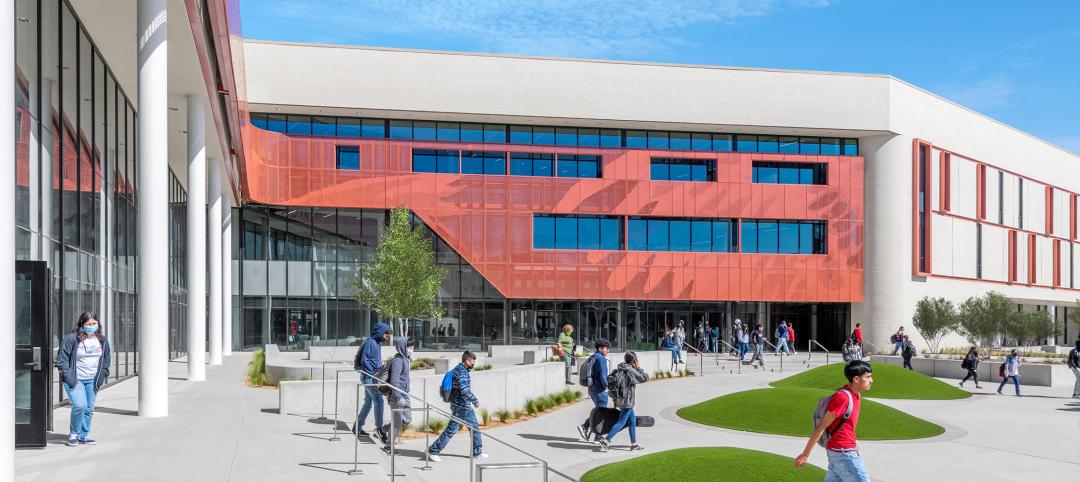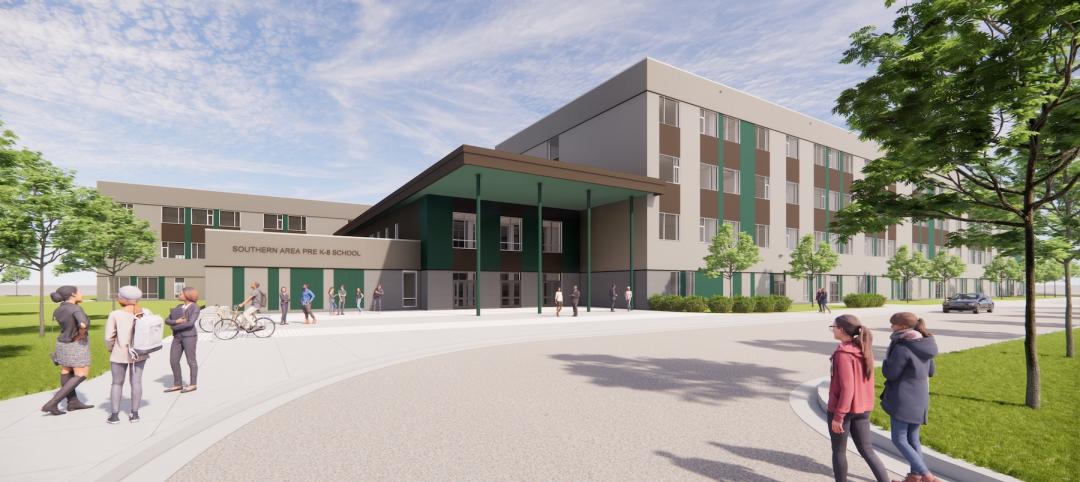Add the explosion in the number of school-aged kids nationally to the glut of huge, vacant stores in many communities and what do you get? Big boxes being turned into schools. For districts facing population pressure, these empty retail buildings can be the key to creating classrooms quickly, and at a significant cost advantage.
SchenkelShultz Architecture, with 10 offices nationally and six in Florida, has done several such conversions. Partner Dan Tarczynski, AIA, of Orlando, says big boxes provide big benefits, including prime locations: "Retailers look for the right housing demographics. When you design a school, this is also the case. When these properties become vacant, they are already in the right spot."
In 2002, SchenkelShultz and design/build partner Centex Rooney transformed unused multipurpose space at Tupperware's corporate campus into a performing arts high school for Osceola County. The district is now revamping an 88,500-sf Kmart for a ninth-grade center in Kissimmee. "The school district needs to be flexible as we look at our future school construction plans," says school board chair Tom Greer. "If there are other big boxes that become available that are the right fit, we may replicate this effort."
A demographic dilemma
The baby boomers' offspring are crowding K-12 facilities all over America. High-immigration areas are doubly squeezed. Schools are shoehorning classrooms into gyms and slipping modular units into playground space. In Chicago, reports of classes held in hallways a decade ago sparked a massive construction initiative; nine years and $2.3 billion later, the district still has $2.5 billion in unfunded capital needs.
Nationwide, more than $20 billion of K-12 construction was completed in 2004, with 80% going for new schools or additions, according to the 10th Annual School Construction Report/2005 (published by School Planning & Management magazine with Market Data Retrieval). Regions experiencing double-digit annual school construction spending growth include the New York-Pennsylvania-New Jersey area, Texas and surrounding states, and California-Nevada-Arizona.
This pace is particularly acute in Florida, where the warm climate and relatively low living costs continue to draw immigrants and interstate migration. "It's predicted that, over the next 20 years, there will be six million people moving to Florida, which averages out to the need for 750 new classrooms a year for 20 years," says SchenkelSchultz's Tarczynski. Lee County alone plans to build 45 schools in the next 10 years.
Compounding the capacity problem is a push toward smaller class size. By state law, Florida schools have just five more years to reduce class sizes to as low as 18 for grades K-3. Hurricane damage has further decreased classroom availability in some Florida towns.
Until recently, Florida districts at least enjoyed modest construction costs. But prices have ballooned with the worldwide materials shortage. "The numbers have gone up 25–30% just in the past year," says Kassey Teimouri, a project designer in SchenkelShultz's Tampa office.
Scheduling is another stress factor. It takes 18–24 months to build a new school, says Tarczynski. That's too slow if a district needs more than 40 or 50 new classrooms every couple of years.
Great location, greater size
Given this convergence of factors, empty big boxes inevitably began to look like schools to district officials. Due to retail restructuring, it's fairly easy to find boxes sized from 40,000 to 200,000 sf. "The retailers here are just getting bigger," says Tarczynski. "If their first store was 40,000 sf, they're building something that's 60,000 sf. If they had 60,000 sf, they now want 80,000 sf."
Big boxes are invariably situated on major arteries, with ample lots for vehicle staging and playgrounds. The surrounding neighborhoods, flush with growing families, usually need more schools, but plans may be hampered by a lack of available building sites or the NIMBY syndrome—"not in my backyard," please.
Location drove the big-box decision for the School District of Lee County, on the state's west coast. "It's very marshy here, and it's hard to find property of sufficient size in the zones where we need new schools," says Michael Smith, the district's director of planning, growth, and school capacity. This fall, Lee County will open two "staging schools" of about 115,000 sf, adapted from Kmarts in Lehigh Acres and Estero. The buildings will serve elementary and secondary students while new facilities are being constructed, and will ultimately become permanent schools.
Big boxes also offer important structural advantages, according to SchenkelShultz's Tarczynski. The open floor plate has a typical bay size of 30×30 to 30×40 sf, ideal for accommodating classrooms. And conversion reduces the need for new materials. The firm's clients have saved 30–35% compared to average new-school costs of $110–$130 per sf.
Districts reap a sustainability bonus when they transform asphalt into green space and recycle existing building stock. Even more appealing for most clients is the 50% reduction in construction time, with a new facility completed in less than a year.
Conversion challenges
Along with its pluses, the big-box strategy has its share of hurdles:
Infrastructure. Adequate HVAC capacity might be available, but the climate zoning is usually wrong. "Because you're changing the building use, you have to upgrade at least some of the mechanical infrastructure," says project designer Teimouri. If overhead space is insufficient for a gym, you might have to reconfigure the roof. Also possible: additional plumbing to support more sinks and toilets, roof membrane replacement, and upgrades for hurricane resistance.
Due diligence. Accurate as-built information is often hard to find, Teimouri says, but it's crucial for producing solid cost estimates and avoiding nasty surprises.
Daylighting. The boxes' squarish footprint makes it tricky to maximize daylight. A typical solution is to put classrooms at the perimeter and core facilities at the center. Clerestories, skylights, and interior windows can channel light deep into the interior.
Wayfinding. "We try to create colors or forms that help students orient themselves," Tarczynski says. "You want maximum efficiency, but you don't want students facing identical corridors over and over."
Image. With a trend toward smaller learning facilities, designers must fight the perception that a converted school will be perceived as a warehouse, with a commensurate loss of prestige. "Will it be thought of as the 'Kmart school'? asks Teimouri. "How do you change the image? This is not a big problem from an architectural standpoint, but it is definitely something to consider."
SchenkelSchultz's ability to meet the challenge may be best illustrated by its conversion of a 40,000-sf Sports Unlimited for Winter Park's Geneva School, a classical academy. The private K-12 school, half empty when it opened in 2003, is now full and thriving.
Though Geneva would eventually like to create a larger new facility on expansive acreage, the conversion has been an excellent stopgap, according to Crosland Stuart, a member of the school's board of governors. The design has boosted the school's visibility, spirit, and enrollment, she says. "We are way ahead of our growth projections, and quite honestly, I'd credit this building for some of that."
Related Stories
K-12 Schools | Feb 13, 2024
K-12 school design trends for 2024: health, wellness, net zero energy
K-12 school sector experts are seeing “healthiness” for schools expand beyond air quality or the ease of cleaning interior surfaces. In this post-Covid era, “healthy” and “wellness” are intersecting expectations that, for many school districts, encompass the physical and mental wellbeing of students and teachers, greater access to outdoor spaces for play and learning, and the school’s connection to its community as a hub and resource.
K-12 Schools | Jan 25, 2024
Video: Research-based design for K-12 schools
Two experts from national architecture firm PBK discuss how behavioral research is benefiting the design of K-12 schools in Texas, Florida, and other states. Dan Boggio, AIA, LEED AP, NCARB, Founder & Executive Chair, PBK, and Melissa Turnbaugh, AIA, NCARB, Partner & National Education & Innovation Leader, PBK, speak with Robert Cassidy, Executive Editor, Building Design+Construction.
K-12 Schools | Jan 8, 2024
Video: Learn how DLR Group converted two big-box stores into an early education center
Learn how the North Kansas City (Mo.) School District and DLR Group adapted two big-box stores into a 115,000-sf early education center offering services for children with special needs.
Designers | Jan 3, 2024
Designing better built environments for a neurodiverse world
For most of human history, design has mostly considered “typical users” who are fully able-bodied without clinical or emotional disabilities. The problem with this approach is that it offers a limited perspective on how space can positively or negatively influence someone based on their physical, mental, and sensory abilities.
Education Facilities | Nov 9, 2023
Oakland schools’ central kitchen cooks up lessons along with 30,000 meals daily
CAW Architects recently completed a facility for the Oakland, Calif., school district that feeds students and teaches them how to grow, harvest, and cook produce grown onsite. The production kitchen at the Unified School District Central Kitchen, Instructional Farm, and Education Center, (“The Center”) prepares and distributes about 30,000 meals a day for district schools lacking their own kitchens.
Products and Materials | Oct 31, 2023
Top building products for October 2023
BD+C Editors break down 15 of the top building products this month, from structural round timber to air handling units.
Giants 400 | Oct 30, 2023
Top 170 K-12 School Architecture Firms for 2023
PBK Architects, Huckabee, DLR Group, VLK Architects, and Stantec top BD+C's ranking of the nation's largest K-12 school building architecture and architecture/engineering (AE) firms for 2023, as reported in Building Design+Construction's 2023 Giants 400 Report.
Giants 400 | Oct 30, 2023
Top 100 K-12 School Construction Firms for 2023
CORE Construction, Gilbane, Balfour Beatty, Skanska USA, and Adolfson & Peterson top BD+C's ranking of the nation's largest K-12 school building contractors and construction management (CM) firms for 2023, as reported in Building Design+Construction's 2023 Giants 400 Report.
Giants 400 | Oct 30, 2023
Top 80 K-12 School Engineering Firms for 2023
AECOM, CMTA, Jacobs, WSP, and IMEG head BD+C's ranking of the nation's largest K-12 school building engineering and engineering/architecture (EA) firms for 2023, as reported in Building Design+Construction's 2023 Giants 400 Report.
K-12 Schools | Oct 21, 2023
The Blueprint Schools Program in Maryland reins in construction time and cost
This collaborative P3 is also committed to expanding participation of small and minority businesses.
















